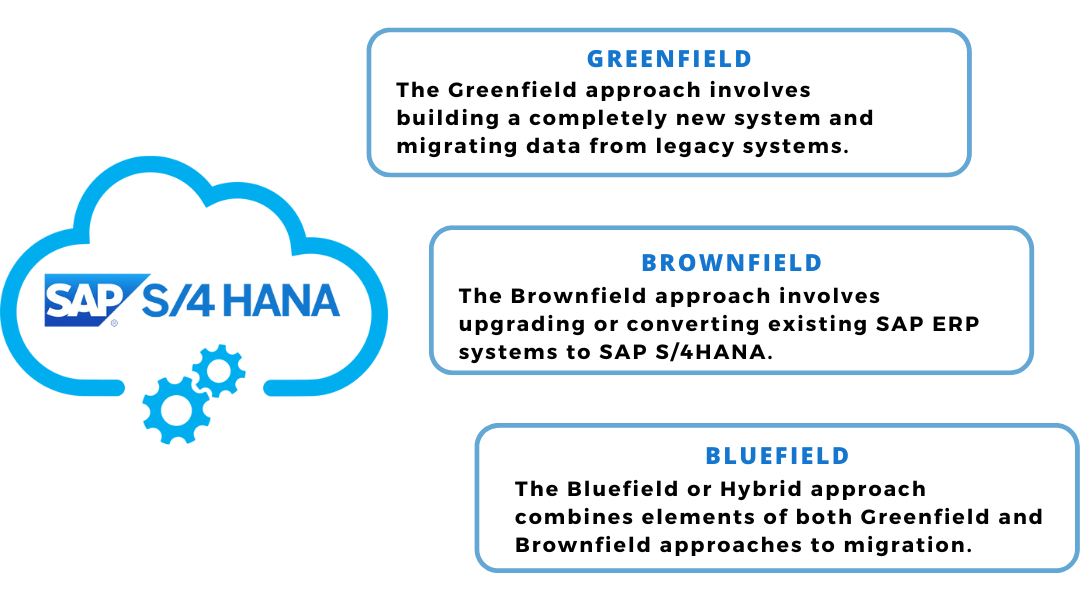A step by step guide to SAP S/4HANA Migration with Brownfield Approach
Table of contents
- Understanding Your SAP S/4HANA Migration Options
- Why Choose the Brownfield Approach for SAP S/4HANA Migration?
- A step by step guide to SAP S/4HANA Migration with Brownfield Approach
Welcome back to our blog series dedicated to navigating SAP S/4HANA migration strategies. In our previous blog: Navigating ERP Transition with SAP S/4HANA’s Greenfield Approach, we explored the theme of the Greenfield approach—a method that will allow you to customize the new system to fit your organization’s unique needs perfectly.
Now, in this second blog post, we’re shifting our focus to Brownfield approach- a method that strikes a delicate balance between innovation and continuity.
The Brownfield approach helps companies smoothly move to SAP S/4HANA. It lets them make the most of what they’ve already put into SAP infrastructure and processes.
Understanding Your SAP S/4HANA Migration Options
Generally, by embracing SAP S/4HANA, organizations can streamline their processes, save time, and discover new avenues for growth and differentiation.

Browse our related blog to uncover the best ways for migration: Five Best Practices For Migrating To SAP S/4HANA.
First, let’s take a step back and refresh our understanding of the spectrum of migration approaches available. SAP S/4HANA migration offers the three primary strategies: Greenfield, Brownfield, and Bluefield.
Greenfield
Approach and benefits:
The Greenfield Approach to moving to SAP S/4HANA is like starting over with a clean page. Instead of trying to fix up or upgrade your old system, you build a completely new one from scratch.
With the Greenfield Approach, you gain the liberty to reconsider your business processes entirely. This method offers high flexibility, enabling you to tailor the new system precisely to suit your organization’s unique requirements. You can capitalize on the latest tools and concepts integrated into SAP S/4HANA.
Challenges:
Nevertheless, this route demands a significant investment of time, resources, and effort in reimplementation, making it a choice suited for those willing to undergo a comprehensive transformation.
Brownfield
Approach and benefits:
At the heart of the Brownfield approach lies the principle of evolution rather than revolution. Unlike the Greenfield approach, which involves building a new system from scratch, or the Bluefield approach, which selectively migrates processes, Brownfield migration focuses on upgrading or converting existing SAP ERP systems to SAP S/4HANA.
This method allows organizations to preserve their investments in customizations, configurations, and business processes while transitioning to the new platform.
The Brownfield approach entails the upgrade or conversion of existing SAP ERP systems to SAP S/4HANA. This method empowers organizations to utilize their existing investments in SAP software and infrastructure while transitioning to the new platform. Brownfield migration typically involves a system conversion or upgrade, preserving current configurations, data, and customizations to minimize disruption to business operations.
Challenges:
While this approach offers a swifter path to SAP S/4HANA adoption, it may necessitate remediation of custom code and meticulous planning to ensure a seamless transition.
Bluefield
Approach and benefits:
Sitting between the Greenfield and Brownfield approaches, the Bluefield approach offers a balanced blend of innovation and continuity. Here, organizations selectively migrate business processes to SAP S/4HANA while retaining others in the legacy system, striking a delicate equilibrium between transformation and stability.
Challenges:
The Bluefield approach empowers organizations to choose the most suitable processes for migration, optimizing their SAP S/4HANA journey while mitigating risks associated with wholesale changes. However, this approach necessitates meticulous planning and integration efforts to ensure seamless operations.
Why Choose the Brownfield Approach for SAP S/4HANA Migration?
Alongside the Greenfield and Bluefield approaches, the Brownfield approach stands out as a pragmatic choice for organizations seeking to transition seamlessly to SAP S/4HANA while leveraging existing investments in SAP infrastructure and processes.
Opting for the Brownfield approach to SAP S/4HANA migration offers several compelling advantages for organizations:
- Preservation of Investments: By upgrading existing SAP ERP systems to SAP S/4HANA, organizations can retain their investments in customizations, configurations, and business processes, minimizing disruption and reducing migration costs.
- Faster Time to Value: Brownfield migration typically offers a faster path to SAP S/4HANA adoption compared to Greenfield implementation, enabling organizations to realize the benefits of the new platform more quickly.
- Risk Mitigation: By leveraging proven SAP infrastructure and processes, Brownfield migration reduces the risk of implementation failures and disruptions to business operations.
- Future-Readiness: SAP S/4HANA equips organizations with the agility and scalability needed to adapt to evolving business requirements and seize new opportunities. The Brownfield approach lays the foundation for future growth and innovation, ensuring long-term success.
A step by step guide to SAP S/4HANA Migration with Brownfield Approach
Successful SAP migration and implementation start with a solid plan. With ITP as your partner, you’re guided through every step from planning to execution.
Enter the Brownfield migration strategy – a method that allows businesses to evolve their existing SAP infrastructure to S/4HANA while preserving valuable investments in customization and configuration. In this guide, we’ll walk you through the essential steps of a Brownfield migration.

Step 1: Evaluate Your Current Environment. Before starting with migration, it’s crucial to take stock of your existing SAP environment. Conduct a comprehensive assessment to evaluate system landscapes, customizations, integrations, data structures, and business processes. This step provides a foundational understanding of your starting point and helps identify potential challenges and opportunities.
Step 2: Define Your Migration Strategy
Determine the most suitable approach, considering factors such as business objectives, timeline, budget, and risk tolerance. In the context of Brownfield migration, the goal is to minimize disruption while maximizing the benefits of S/4HANA adoption. Define clear objectives, milestones, and success criteria to guide your journey. This step provides a foundational understanding of your starting point and helps identify potential challenges and opportunities.
Step 3: Prepare Your Landscape for Migration
Preparation is key to a smooth migration experience. This involves ensuring that your current landscape meets the prerequisites for S/4HANA compatibility, addressing any technical or functional gaps, and optimizing system performance. Collaborate with your IT team, SAP experts, and stakeholders to develop a detailed migration plan, encompassing data cleansing, system updates, and testing procedures.
Step 4: Execute the Migration Plan
With preparations complete, it’s time to execute your migration plan in earnest. Follow a structured approach, adhering to best practices and leveraging automation tools wherever possible to streamline the process. Execute data migration activities, perform system conversions, and validate results rigorously to ensure accuracy and integrity. Communication and collaboration are paramount during this phase to minimize disruptions and address any unforeseen challenges effectively.
Step 5: Validate and Optimize
Post-migration validation is critical to ensuring the success of your S/4HANA deployment. Conduct comprehensive testing to verify system functionality, data integrity, and performance levels.Leverage insights gathered during testing to fine-tune configurations, optimize system performance, and maximize the value of your S/4HANA investment.
By assessing alignment with future strategies, acknowledging challenges, evaluating system agility, and gauging organizational readiness for change, organizations can make informed decisions about transitioning to SAP S/4HANA.
Take the first step towards a successful SAP S/4HANA migration journey today. Contact us to schedule a free consultation and ensure you’re on the right path for your migration. Let us guide you to maximize the benefits of SAP S/4HANA for your business.
Similar articles